Do you know about “Tebichi”, a traditional and famous dish in Okinawa? Although you may have heard of it, many people may not have actually tasted it. In this article, we will mainly introduce the origin of its name and flavors. You won’t want to miss the Tebichi recipe that allows you to savor its soft and tender texture!
What is Tebichi Soba?
Tebichi Soba is a delightful dish that represents the unique flavors of Okinawa. It is a variation of traditional Okinawan soba, featuring the star ingredient called “tebichi” – simmered pork trotters. Tebichi refers to both the pork trotters themselves and the simmered dish they are used in.
The tender pork trotters are simmered with a blend of sugar, soy sauce, and awamori, a local distilled liquor. This flavorful topping is then paired with the comforting warmth of soba noodles. The collagen-rich goodness that oozes from the pork skin is believed to have beauty benefits, making it immensely popular among women.
About Okinawan cuisine culture
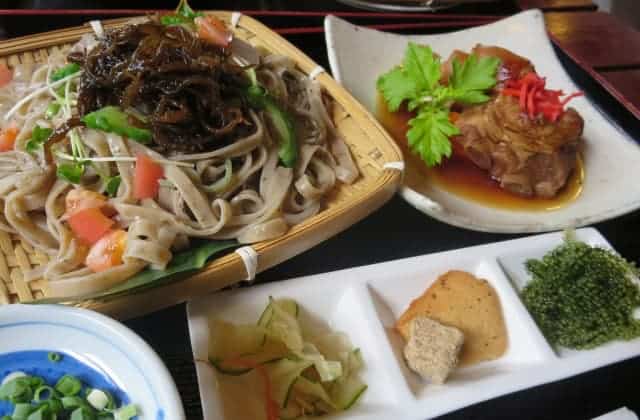
Features
Okinawan cuisine, also known as Ryūkyūan cuisine (琉球料理, Ryūkyū ryōri), is influenced by the rich heritage of the Ryukyu Kingdom. It has its own distinct style and differs from mainland Japanese cuisine due to cultural variations, historical connections with other regions, diverse climate conditions, and the availability of unique vegetables and ingredients. These factors contribute to the wide range of flavors and cooking methods found in Okinawan dishes, making it a fascinating and separate branch of Japanese culinary tradition.
Influenced by Chinese, Southeast Asian, and Japanese flavors, Okinawan cuisine combines a variety of tastes and textures. Fresh seafood, tropical fruits, and vegetables like bitter melon and purple sweet potatoes are key components of Okinawan dishes. The cuisine also features special ingredients like goya (bitter gourd) and mozuku (seaweed), which add depth to the flavors. Okinawan cuisine is celebrated for its health benefits, with a focus on longevity and well-being. It includes lean proteins, minimal oil usage, and a wide range of colorful vegetables, making it a nutritious and balanced culinary tradition. Whether it’s the famous Okinawa soba, tasty stir-fried dishes, or the beloved Rafute (slow-cooked pork belly), Okinawan cuisine delights with its vibrant flavors and cherished traditions.
Pork in Okinawan cuisine
Historically, pork has been consumed in Okinawa since the era of the Ryukyu Kingdom. While beef was also popular, the royal government prohibited its consumption during the Edo period, leading to an increased preference for pork. Moreover, to host Chinese diplomatic missions engaged in trade, a substantial quantity of pork was necessary. Consequently, the royal government actively promoted pig farming, fostering the widespread consumption of pork throughout Okinawa.
Presently, pork is incorporated into a variety of dishes, exemplifying Okinawan cuisine’s practice of utilizing every part of the pig, from the face and ears to the blood, in line with the adage, “everything except the squeal.”
History
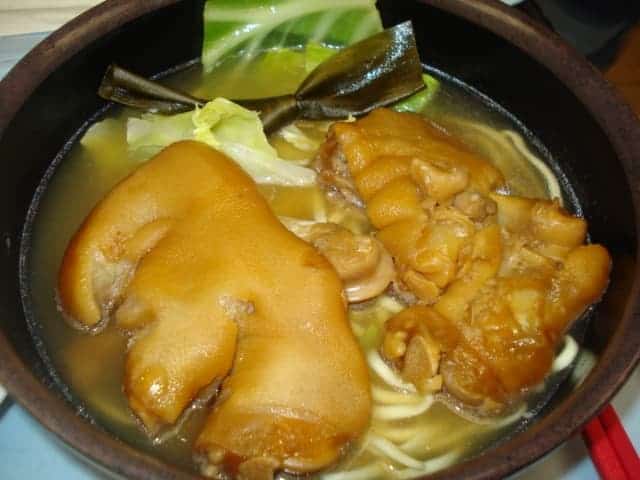
History of Pork in Okinawan cuisine
Origin
The history of pigs in Okinawa has deep roots that can be traced back to the 15th century. It is believed that pigs were introduced to the region from China’s Fujian province during this time. However, it wasn’t until the 18th century that pork became more accessible to the general population.
During the Ryukyu Kingdom era, one of the reasons for the popularity of pigs in Okinawa was to entertain Chinese envoys who visited the kingdom. These envoys, consisting of hundreds of people, stayed in Okinawa for several months. To cater to the Chinese visitors’ love for pork, a substantial amount of pigs was needed. However, the Ryukyu Kingdom alone couldn’t meet the demand for pork. They had to source pigs from neighboring islands like Amami and Oki-no-Erabu to accommodate the envoys’ needs.
From 18th century
It was in the 18th century that the Ryukyu Kingdom started to increase the number of livestock farmers to ensure a steady supply of pork for the envoys. The introduction of sweet potatoes during this time played a pivotal role in pig farming. Sweet potatoes became a staple food for the common people, and the byproducts like skins, leaves, and vines were utilized as pig feed. This breakthrough allowed pig farming to flourish, making pork gradually more accessible to the general population of Okinawa.
However, even during the Meiji period following the Ryukyu Disposition, pork remained a luxury item. While pig farming became more widespread, everyday consumption of pork was limited to a few affluent individuals. The majority of the population could enjoy pork only on special occasions such as the Lunar New Year or Obon, which occurred once or twice a year.
The pig industry in Okinawa continued to thrive until the approach of war during the Taisho and Showa eras. The war brought about significant challenges, including food shortages, which affected not only the pork culture but also overall food availability in Okinawa.
Despite these challenges, the history of pigs in Okinawa showcases the region’s early connection with Chinese culinary influences and the efforts made to accommodate important guests. The introduction of sweet potatoes revolutionized pig farming and contributed to making pork gradually more accessible to the common people, albeit still considered a luxury item during that time.
出典: 内閣府 (https://www8.cao.go.jp/okinawa/8/2023/okinawahukki50/content/eat02.html)
The origin of Tebichi
Tebichi Soba has a long history in Okinawa, reflecting the region’s cultural heritage and culinary traditions. It is believed that the dish originated during the time of the Ryukyu Kingdom (1429-1879), when Okinawa had close trade ties with China. Tebichi Soba draws inspiration from Chinese noodle dishes that featured braised or stewed pork.
As Okinawa embraced this culinary influence, Tebichi Soba gained popularity as a hearty and flavorful dish. The key element is the pig trotters, which are simmered slowly in a rich broth. The broth is typically seasoned with soy sauce, salt, and other aromatic ingredients, allowing the flavors to meld together. The result is tender and succulent pork trotters.
Over time, Tebichi Soba became a beloved staple in Okinawan cuisine, loved for its satisfying combination of savory flavors and textures. The dish is often served with buckwheat noodles, which are boiled and then topped with the braised pig trotters and the flavorful broth.
Today, Tebichi Soba stands as a symbol of Okinawa’s culinary heritage, showcasing the region’s unique blend of cultural influences. It can be found in restaurants and food stalls throughout Okinawa, preserving the history and traditions of this dish.
Health Benefits
Tebichi soba offers several health benefits for those who enjoy this traditional Okinawan dish. One notable benefit is its collagen content. The gelatinous texture of the tebichi meat, derived from pig’s trotters, is rich in collagen, which is known for promoting healthy skin, supporting joint health, and aiding digestion.
Additionally, tebichi soba includes soba noodles made from buckwheat, which are a good source of dietary fiber, minerals, and antioxidants. The combination of collagen-rich tebichi and nutrient-packed soba noodles makes this dish a potentially nourishing choice. However, it’s important to consume tebichi soba in moderation as part of a balanced diet, considering its overall richness and calorie content.
Some tips on portion control when eating tebichi soba:
1. Be mindful of serving size: Pay attention to the recommended serving size for tebichi soba, which is typically mentioned in recipes or provided by restaurants. Stick to the suggested portion to ensure you’re not overindulging.
2. Fill up on vegetables: Prioritize filling a significant portion of your plate with vegetables. This can help you feel more satisfied while reducing the portion of tebichi soba. Consider adding a side salad or steamed vegetables to your meal.
3. Choose whole grain soba: Look for soba noodles made from whole grains, such as 100% buckwheat or a blend of buckwheat and whole wheat. Whole grain options provide more fiber, nutrients, and a lower glycemic index compared to refined flour noodles.
Tebichi Soba FAQ
- What is the etymology of the word ‘tebichi’ in Okinawa?
-
The etymology of the word “tebichi” is not definitive, but there is a theory that it originated from the term “tebiki,” which means “guidance” or “assistance.” In Okinawan dialect, it is sometimes pronounced as “tibichi.”
- Can tebichi soba be prepared at home?
-
Tebichi soba can be prepared at home, but it is a time-consuming process that requires skill to achieve the desired flavors and textures. Simmering the tebichi for an extended period and preparing the flavorful broth are key steps. Recipes with step-by-step instructions are available for those interested in making tebichi soba at home. See below for details!
How to make Tebichi Soba at home?
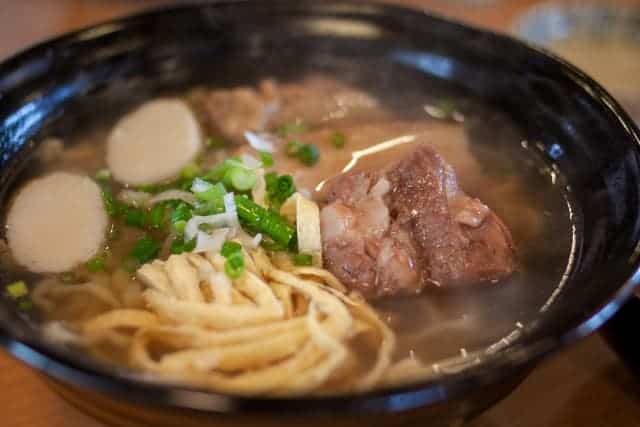
Ingredients
| Ingredients | Amount |
| Pork trotters | 4 |
| Bonito dashi | 10 cups |
| Awamori (Okinawan distilled liquor) | 1/2 cup |
| Orion beer | 1/2 cup |
| Soy sauce | 1/2 cup |
| Mirin | 1/2 cup |
| Sake | 1 cup |
| Tamari soy sauce | 1/4 cup |
| Garlic | 5 cloves |
| Ginger | 20g |
| Green onion | 1 stalk |
| Bonito granulated dashi | 1 tbsp |
Instructions
Cleaning them and removing any hair
Place the pork trotters in a pot and add enough water to cover them.
Bring the water to a boil and let it boil for a few minutes to remove any impurities. Skim off any foam or scum that rises to the surface.
After boiling, remove the pork trotters from the pot and rinse them under cold water to remove any remaining impurities.
Crush the garlic cloves and grate the ginger. Cut the green onion in half.
In the same pot, combine the bonito dashi, awamori, Orion beer, soy sauce, mirin, sake, tamari soy sauce, crushed garlic, grated ginger, green onion, and bonito granulated dashi. Stir well to combine.
Add the pork trotters back into the pot with the sauce mixture. Bring the mixture to a boil, then reduce the heat to low. Skim off any foam or scum that may rise to the surface.
Let the pork trotters simmer on low heat for about 2-3 hours, or until they become tender and can easily be cut with chopsticks. If using a pressure cooker, cook for about 20-30 minutes.
Once the pork trotters are tender, remove them from the pot and slice them into bite-sized pieces.
Cook soba noodles according to the package instructions.
Serve the cooked soba noodles in bowls and top them with the sliced pork trotters. Ladle the broth over the noodles and garnish with desired toppings such as green onions or grated ginger.
Tebichi soba is now ready to be enjoyed. Itadakimasu!
Recommended restaurants
Nanbu Soba (南部そば)
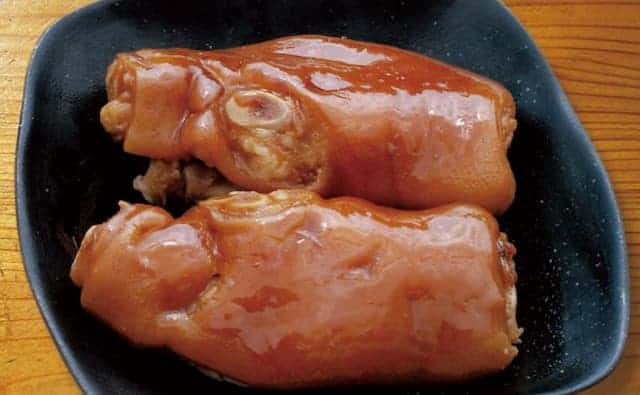
Looking to enjoy delicious Tebichi Soba? Look no further than Nanbu Soba, a dedicated Okinawan soba restaurant. They serve homemade, smooth and chewy noodles, along with tasty tebichi (pig’s trotters). Nanbu Soba offers generous portions of flavorful and collagen-rich Nanbu Soba bowls.
They serve a variety of delicious soba dishes, including their famous Tebichi Soba. This special dish features homemade noodles that are chewy and topped with tasty tebichi (pig’s trotters). Nanbu Soba cooks the tebichi to perfection, creating a flavorful and satisfying experience. If you enjoy soba or want to try something new, Nanbu Soba is the perfect place to enjoy the authentic and mouthwatering flavors of Tebichi Soba. Don’t miss the chance to visit this restaurant and enjoy their delightful Tebichi Soba dish.

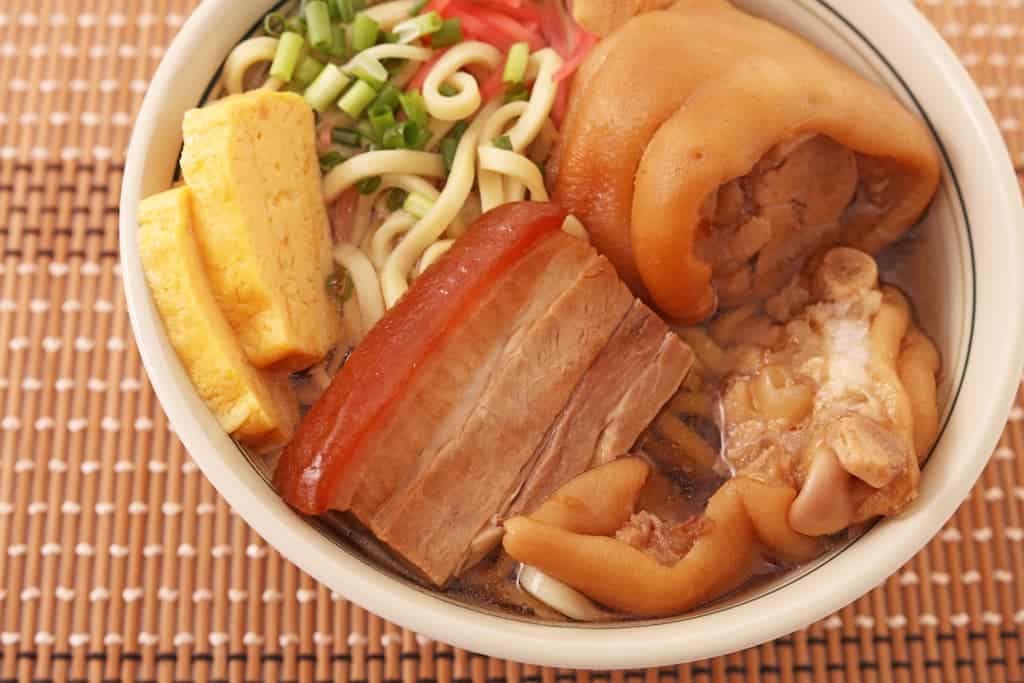
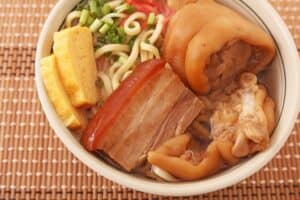
Comments